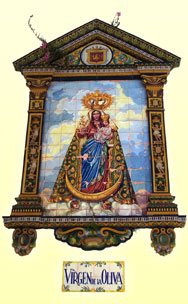- Villa search

- Canaries
- Caribbean
- Croatia, Bulgaria and Hungary
- Cyprus
- Florida
- France and Corsica
- Greece
- Italy
- Lakes and Mountains
- Madeira
- Malta and Gozo
- Portugal
- South Africa
- Spain - Balearics

Image of the Virgin on Vejer’s church
The Costa de la Luz is a windy place and wind means one thing – it’s a great place for watersports such as sailing and kite surfing. Tarifa is the European capital of windsurfing – when you drive in you’ll see surf shops lining the road like barnacles. Brightly-coloured kites – those of the surfers – can be seen at most beaches between here and Zahara.
On foot in Tarifa you get a strong feeling of its history, especially around the old Puerta de Jerez, Alameda gardens and the church of San Mateo. The first Spanish town taken in the Arab conquest in 710AD, its ferry signs are in Arabic and at night the lights of the ports and villages on the Moroccan coast – only nine miles away – can be seen.
Seville is a beacon of Andalucian, Roman and Moorish culture worth the two-hour drive north.
Cadiz is closer. Built on a peninsula on the toecap of Europe, it was an important trading centre for the Romans and Arabs. Columbus sailed to the Americas from Cadiz, where the 18th century gold-domed cathedral on the seafront is a reminder of the wealth shipped back from Latin America by the Spanish conquistadors.
Nearby are the sherry-exporting towns of Jerez, Sanlucar de Barrameda and Puerto de Santa María, the only ones allowed by international law to call their wine ‘sherry’. Go to the bodegas for tasting sessions.
There’s a stretch of the Coast of Light that might interest students of British history. London’s Trafalgar Square takes its name from the battle that took place at Cape Trafalgar – a few miles south of Conil – in 1805, when Nelson defeated the combined French and Spanish navies.
Sand dunes thick with clumps of grass and wild flowers lead up to a simple lighthouse. From here, you can look out over the Playa de Almas – beach of souls – and then walk back to the safer side of the promontory for a swim in the cool Atlantic waters at Playa Trafalgar.

The lighthouse at Cape Trafalgar
home | destinations and editorial | villa search | property for sale | car hire | flights | services
villaseek blog | contact villaseek | links and resources | advertise your villa© Dune Root Ltd and Villaseek.com 2012 - Caribbean
- Canaries